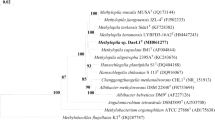Abstract
Strain GB isolated from the maize rhizosphere is a gram-negative, aerobic, non-spore-forming, nonpigmented, nonmotile, chemolithotrophic, facultatively methylotrophic bacterium. Cells are cocci or short rods. The strain does not require vitamins. Optimum growth in a medium with methanol occurs at 38–42°C at pH 8.0–9.2. The doubling time is 12 h. In addition to methanol, the bacterium can grow on methylamine, dimethylformamide, acetone, thiosulfate + NaHCO3, and in an atmosphere of H2 + CO2 + O2. Methanol and methylamine are oxidized by the respective dehydrogenases to CO2 via formaldehyde and formate, respectively. The CO2 produced is assimilated via the ribulose bisphosphate pathway. Fatty acids are dominated by cyclopropanoic (58–61%), palmitic (24–26%), and octadecanoic (8–9%) acids. The main phospholipids are phosphatidylglycerol, phosphatidylethanolamine, and phosphatidylcholine. The major ubiquinone is Q10. The bacterial genome contains genes controlling the synthesis and secretion of cytokinins. The culture liquid exhibits cytokinin activity. The G+C content of DNA is 62.5 mol %, as determined from the DNA thermal denaturation temperature Tm). Strain GB shows a moderate degree of DNA-DNA homology (<40%) with the type representatives of the genusParacoccus. Based on the data obtained, the bacterium was classified as a new species of this genus, namedP. kondratievae.
Similar content being viewed by others
References
Fall, R., Cycling of Methanol between Plants, Methylotrophs and the Atmosphere,Microbial Growth on C 1-Compounds, Lidstrom, M.E. and Tabita, F.R., Eds., Dordrecht: Kluwer, 1996, pp. 343–350.
Corpe, W.A. and Rheem, S., Ecology of the Methylotrophic Bacteria on Living Leaf Surfaces,FEMS Microbiol. Ecol., 1989, vol. 62, no. 4, pp. 243–250.
Holland, M.A.,Methylobacterium and Plants,Rec. Res. Develop. Plant Physiol., 1997, vol. 1, no. 1, pp. 207–213.
Long, R., Morris, R., and Polacco, J., Cytokinin Production by Plant-Associated Methylotrophic Bacteria,Am. Soc. Plant Physiol., 1997, Abstr. 1168.
Shepelyakovskaya, A.O., Doronina, N.V., Laman, A.G., Brovko, F.A., and Trotsenko, Yu.A., New Data on the Ability of Aerobic Methylotrophic Bacteria to Synthesize Cytokinins,Dokl. Akad. Nauk, 1999, vol. 368, no. 4, pp. 555–557.
Urakami, T., Tamaoka, J., Suzuki, K.-L, and Komagata, K.,Paracoccus alcaliphilus sp. nov., an Alkaliphilic and Facultatively Methylotrophic Bacterium,Int. J. Syst. Bacteriol., 1989, vol. 39, no. 2, pp. 116–121.
Siller, H., Rainey, F.A., Stackebrandt, E., and Winter, J., Isolation and Characterization of a New Gram-Negative, Acetone-Degrading, Nitrate-Reducing Bacterium from Soil,Paracoccus solventivorans sp. nov.,Int. J. Syst. Bacteriol., 1996, vol. 46, no. 4, pp. 1125–1130.
Doronina, N.V., Trotsenko, Y.A., Krauzova, V.I., and Suzina, N.E.,Paracoccus methylutens sp. nov., a New Aerobic Facultatively Methylotrophic Bacterium Utilizing Dichloromethane,Syst. Appl. Microbiol., 1998, vol. 21, no. 2, pp. 230–236.
Marmur, J.A., A Procedure for the Isolation of Deoxyribonucleic Acid from Microorganisms,J. Mol Biol, 1961, vol. 3, no. 2, pp. 208–218.
Owen, R.J. and Lapage, S.P., The Thermal Denaturation of Partly Purified Bacterial Deoxyribonucleic Acid and Its Taxonomic Applications,J. Appl. Bacteriol., 1976, vol. 41, no. 3, pp. 335–340.
De Ley, J., Cattoir, H., and Reynaerts, A., The Quantitative Measurement of DNA Hybridization from Renaturation Rates,Eur. J. Biochem., 1970, vol. 12, no. 1, pp. 133–142.
Doronina, N.V., Govorukhina, N.I., Lysenko, A.M., and Trotsenko, Yu.A., The DNA-DNA Homology Analysis of Obligately Methylotrophic Bacteria,Mikrobiologiya, 1988, vol. 57, no. 4, pp. 629–633.
Barry, G.F., Rogers, S.G., Fraley, R.T., and Brand, L., Identification of a Cloned Cytokinin Biosynthetic Gene,Proc. Natl. Acad. Sci. USA, 1984, vol. 81, pp. 4776–4780.
Powell, G.K. and Morris, R.O., Nucleotide Sequence and Expression of aPseudomonas savantanoi Cytokinin Biosynthetic Gene Homology withAgrobacterium tumefaciens tmr andtzs Loci,Nucleic Acids Res., 1986, vol. 14, pp. 2555–2565.
Cizkova, R., Acidification Stress of Root Environments Related to Endogenous Cytokinins and Gibberellins in Oak Seedlings,Biol. Plantarum, 1990, vol. 32, no. 1, pp. 97–103.
Baalsrud, K. and Baalsrud, K.S., Studies onThiobacillus denitrificans, Arch. Mikrobiol., 1954, vol. 20, no. 1, pp. 34–62.
van Verseveld, H.W. and Stouthamer, A.H., The GenusParacoccus, The Prokaryotes. A Handbook on the Biology of Bacteria: Ecophysiology, Isolation, Identification, Applications, 2nd ed., Balow, A.et al., Eds., New York: Springer, 1992, vol. 3, pp. 2322–2334.
Urakami, T., Araki, H., Oyanagi, H., Suzuki, K.-I., and Komagata, K.,Paracoccus aminophilus sp. nov. andParacoccus aminovorans sp. nov., Which Utilize N,N-Dimethylformamide,Int. J. Syst. Bacteriol., 1990, vol. 40, no. 3, pp. 287–291.
Ohara, M., Katayama, Y., Tsuzaki, M., Nakamoto, S., and Kuraishi, H.,Paracoccus kocurii sp. nov., a Tetramethylammonium Assimilating Bacterium,Int. J. Syst. Bacteriol., 1990, vol. 40, no. 3, pp. 292–296.
Katayama, Y., Hiraishi, A., and Kuraishi, H.,Paracoccus thiocyanatus sp. nov., a New Species of Thiocyanate-utilizing Facultative Chemolithotroph, and Transfer ofThiobacillus versutus to the GenusParacoccus asParacoccus versutus comb. nov. with Emendation of the Genus,Microbiology, 1995, vol. 141, pp. 1469–1477.
Lipski, A., Reichert, K., Reuter, B., Spoer, C., and Altendorf, K., Identification of Bacterial Isolates from Biofilters asParacoccus alkenifer sp. nov. andParacoccus solventivorans with Emended Description ofParacoccus solventivorans, Int. J. Syst. Bacteriol., 1998, vol. 48, no. 2, pp. 529–536.
Harker, M., Hirschberg, J., and Oren, A.,Paracoccus marcusii sp. nov., an Orange Gram-Negative Coccus,Int. J. Syst. Bacteriol., 1998, vol. 48, no. 2, pp. 543–548.
Rainey, F.A., Kelly, D.P., Stackebrandt, E., Burghart, J., Hiraishi, A., Katayama, Y., and Wood, A.P., A Reevaluation of the Taxonomy ofParacoccus denitrificans and a Proposal for the CombinationParacoccus pantotrophus comb, nov.,Int. J. Syst. Bacteriol., 1999, vol. 49, no. 3, pp. 645–651.
Tsubokura, A., Yoneda, H., and Mizuta, H.,Paracoccus carotinifaciens sp. nov., a New Aerobic Gram-Negative Astaxanthin-producing Bacterium,Int. J. Syst. Bacteriol., 1999, vol. 49, no. 1, pp. 277–282.
Author information
Authors and Affiliations
Rights and permissions
About this article
Cite this article
Doronina, N.V., Trotsenko, Y.A. A novel plant-associated thermotolerant alkaliphilic methylotroph of the genusParacoccus . Microbiology 69, 593–598 (2000). https://doi.org/10.1007/BF02756814
Received:
Issue Date:
DOI: https://doi.org/10.1007/BF02756814



